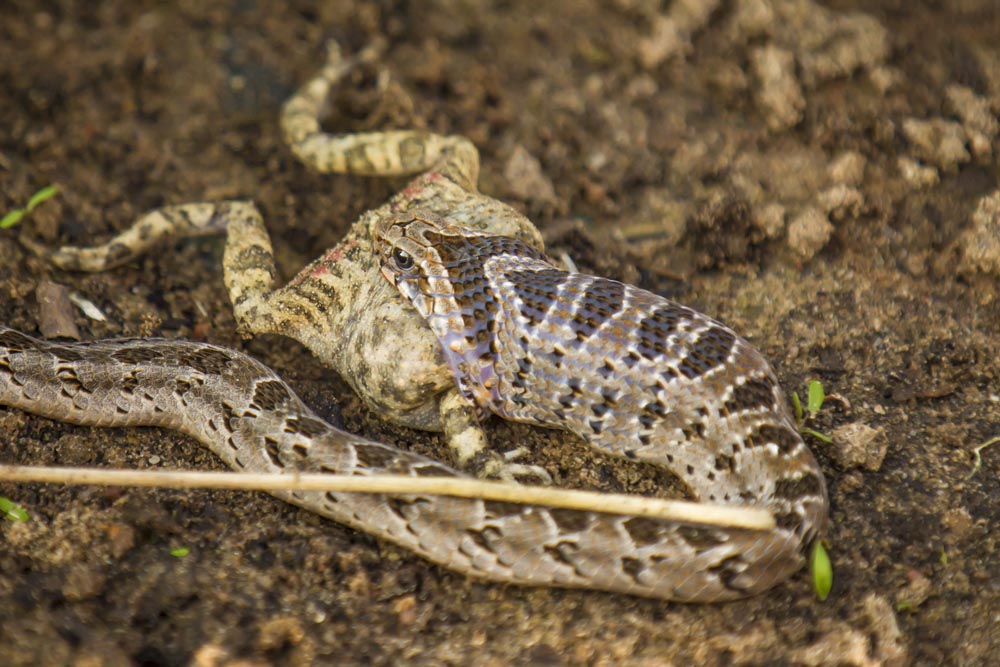There are three main categories of venom found in southern African snakes.
Cytotoxic Venom
Found in the “front-fanged” snakes such as the Puff Adder, Gaboon Adder (these fangs are also hinged), Mozambique Spitting Cobra, Black Necked Spitting Cobra, Black Spitting Cobra and also the Rinkhals.*
Snakes use cytotoxins in their venom to kill their food-source prey quickly, and then to break down body tissue of their victims in order to help with the digestive process.
The danger of Cytotoxic venom for human beings, is that it essentially attacks and breaks down the cell structure, leading to swelling and necrosis or breakdown of the cell tissue. Snakebites from the smaller adders, such as the Berg Adder or Rhombic Night Adder, will not be as severe to human beings, as from their larger cousins.
Typical symptoms suffered by human beings are a severe, burning pain at the point of the bite, followed by swelling in the entire limb that was bitten that can continue for as long as 48-72 hours. Such swelling will appear to split the skin and flesh, to reveal an ugly open wound as the tissue continues to swell, break down and disintegrate. The danger is therefore exacerbated as there is a strong possibility that a secondary bacterial infection will set in, in the open wound.
Neurotoxic Venom
Also found in the “front-fanged” snakes such as the Black and Green Mambas, Cape Cobra, Snouted Cobra, Forest Cobra and Rinkhals.*
Snakes use neurotoxins in their venom to quickly immobilise their natural food-source prey by attacking the nervous system of their prey. Typical symptoms suffered by human beings are some pain to the bite area but minimal or no swelling at the bite site. Slurred speech, pins-and-needles or numbness around the mouth, blurred/double vision, drooping eyelids (Ptosis) and drowsiness. Nausea and vomiting, increased sweating within 5-30 minutes, which can continue for about three hours until the respiratory system starts to shut down, leading to laboured breathing, muscle paralysis, respiratory failure and finally death by asphyxiation.
It is terribly important to ensure that the victim has an open airway as death occurs from asphyxiation and not the actual bite.
Haemotoxic Venom
Found in “back-fanged snakes” like the Boomslang, Vine Snake (aka Bird Snake).
Snakes use haemotoxins to kill their food-source prey, by destroying red blood cells (Hemolysis), disrupt blood clotting and/or cause organ degeneration and generalised tissue damage. The venom is released via canals or grooves in the back fangs, causing it to flow into the victim during a slow, chewing process.
Symptoms suffered by human beings are a painful bite, minimal or no swelling at the bite sight, followed by blood oozing from the bite site. Headaches, mental confusion, nausea, vomiting and increased sweating will follow several hours after the bite. Bleeding from all the mucous membranes and eventually severe internal haemorrhaging between 12-36 hours after the bite.
These back-fanged snakes very seldom attack human beings. If they are induced to bite, they will use a slow, saw-like action which enables one to pull away very quickly before too much damage has been done.
*It should be noted that Rinkhals venom displays similar Nuerotoxic and Cytotoxic post bite symptoms.
FAQs
What are the chances of death by snakebite?
It is important to understand that fewer than ten percent (10%) of snake species in southern Africa are dangerously venomous.
Have I been envenomated (injected with venom)?
Snakes have full control over the flow of their own venom and a bite doesn’t necessarily mean that you have been envenomated. You should, as a precautionary measure, always assume the worst.
What marks should I look for?
Envenomation can display as two distinct fang punctures (very rarely), several punctures, a single deep scratch or even a tiny scratch, though, in many cases no distinct puncture wounds can be identified.
What will happen to me?
Reaction to envenomation varies and will depend on the amount of venom released, in relation to the body mass of the victim. The greater the ratio, the greater the severity of the bite. It stands to reason that small children will usually suffer more than a larger adult. While many people are bitten, providing the victims are attended to quickly and appropriately, very few people end up dying.
Must I know what bit me?
Identification of the snake after a bite is handy, but not imperative. DO NOT try to catch or kill the snake. A secondary bite will only complicate matters. Treatment is administered according to the symptoms being displayed by the victim. It is most important to ask the victim what they are feeling, and to pay close attention to the victim’s behaviour and clarity of the victim’s response. Continue to closely monitor and observe the victim for typical symptoms, as these will change in the ensuing hours after the bite.
Often, typical symptoms of shock (profuse sweating, thumping heart and difficulty in breathing) can be confused with post snakebite symptoms and should be closely monitored for change in order to differentiate them. When in doubt, believe the worst!
Keep the victim, calm, warm and awake and ensure that they can breathe freely. Evacuate them to a medical centre with a trauma unit as soon as possible!
